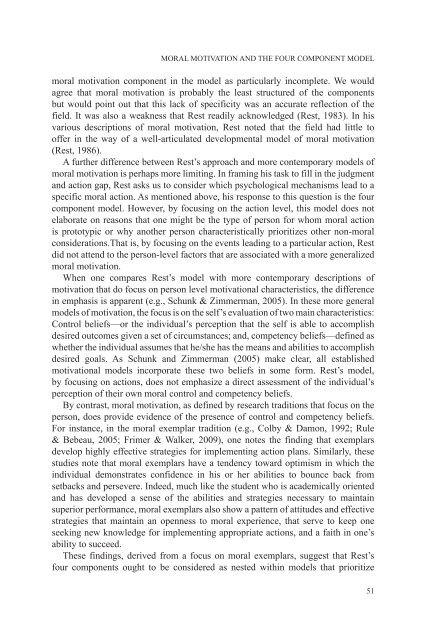Handbook of moral motivation: Theories, models ... - Sense Publishers
Handbook of moral motivation: Theories, models ... - Sense Publishers
Handbook of moral motivation: Theories, models ... - Sense Publishers
- No tags were found...
You also want an ePaper? Increase the reach of your titles
YUMPU automatically turns print PDFs into web optimized ePapers that Google loves.
MORAL MOTIVATION AND THE FOUR COMPONENT MODEL<strong>moral</strong> <strong>motivation</strong> component in the model as particularly incomplete. We wouldagree that <strong>moral</strong> <strong>motivation</strong> is probably the least structured <strong>of</strong> the componentsbut would point out that this lack <strong>of</strong> specificity was an accurate reflection <strong>of</strong> thefield. It was also a weakness that Rest readily acknowledged (Rest, 1983). In hisvarious descriptions <strong>of</strong> <strong>moral</strong> <strong>motivation</strong>, Rest noted that the field had little to<strong>of</strong>fer in the way <strong>of</strong> a well-articulated developmental model <strong>of</strong> <strong>moral</strong> <strong>motivation</strong>(Rest, 1986).A further difference between Rest’s approach and more contemporary <strong>models</strong> <strong>of</strong><strong>moral</strong> <strong>motivation</strong> is perhaps more limiting. In framing his task to fill in the judgmentand action gap, Rest asks us to consider which psychological mechanisms lead to aspecific <strong>moral</strong> action. As mentioned above, his response to this question is the fourcomponent model . However, by focusing on the action level, this model does notelaborate on reasons that one might be the type <strong>of</strong> person for whom <strong>moral</strong> actionis prototypic or why another person characteristically prioritizes other non-<strong>moral</strong>considerations.That is, by focusing on the events leading to a particular action, Restdid not attend to the person-level factors that are associated with a more generalized<strong>moral</strong> <strong>motivation</strong> .When one compares Rest’s model with more contemporary descriptions <strong>of</strong><strong>motivation</strong> that do focus on person level <strong>motivation</strong>al characteristics, the differencein emphasis is apparent (e.g., Schunk & Zimmerman, 2005). In these more general<strong>models</strong> <strong>of</strong> <strong>motivation</strong>, the focus is on the self’s evaluation <strong>of</strong> two main characteristics:Control beliefs—or the individual’s perception that the self is able to accomplishdesired outcomes given a set <strong>of</strong> circumstances; and, competency beliefs—defined aswhether the individual assumes that he/she has the means and abilities to accomplishdesired goals . As Schunk and Zimmerman (2005) make clear, all established<strong>motivation</strong>al <strong>models</strong> incorporate these two beliefs in some form. Rest’s model,by focusing on actions, does not emphasize a direct assessment <strong>of</strong> the individual’sperception <strong>of</strong> their own <strong>moral</strong> control and competency beliefs.By contrast, <strong>moral</strong> <strong>motivation</strong> , as defined by research traditions that focus on theperson, does provide evidence <strong>of</strong> the presence <strong>of</strong> control and competency beliefs.For instance, in the <strong>moral</strong> exemplar tradition (e.g., Colby & Damon, 1992; Rule& Bebeau, 2005; Frimer & Walker, 2009), one notes the finding that exemplarsdevelop highly effective strategies for implementing action plans. Similarly, thesestudies note that <strong>moral</strong> exemplars have a tendency toward optimism in which theindividual demonstrates confidence in his or her abilities to bounce back fromsetbacks and persevere. Indeed, much like the student who is academically orientedand has developed a sense <strong>of</strong> the abilities and strategies necessary to maintainsuperior performance, <strong>moral</strong> exemplars also show a pattern <strong>of</strong> attitudes and effectivestrategies that maintain an openness to <strong>moral</strong> experience , that serve to keep oneseeking new knowledge for implementing appropriate actions, and a faith in one’sability to succeed.These findings, derived from a focus on <strong>moral</strong> exemplars, suggest that Rest’sfour components ought to be considered as nested within <strong>models</strong> that prioritize51














